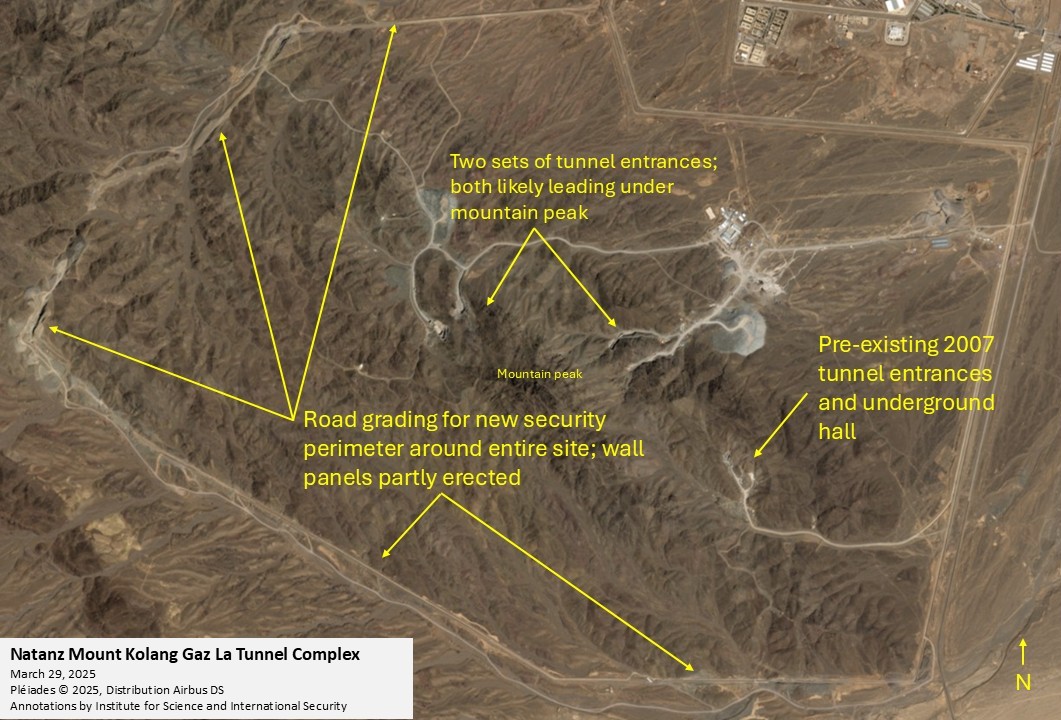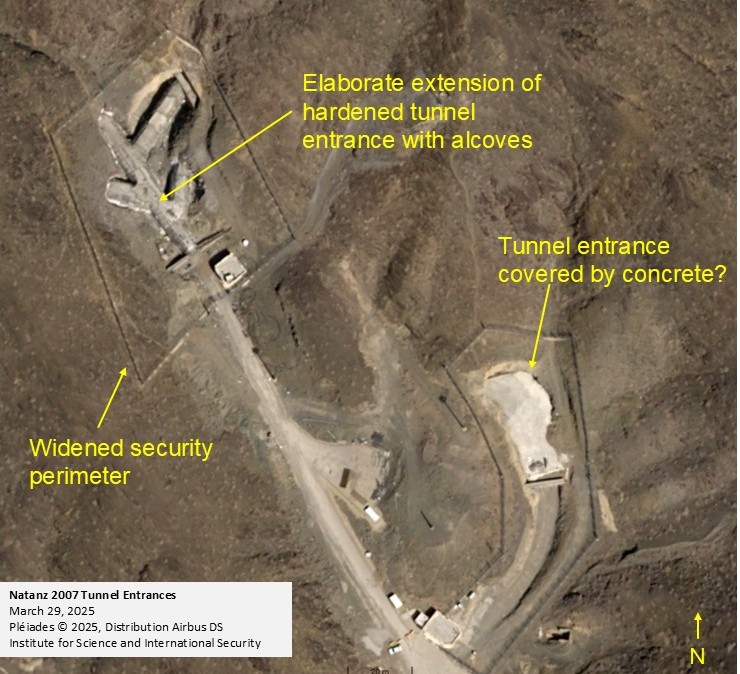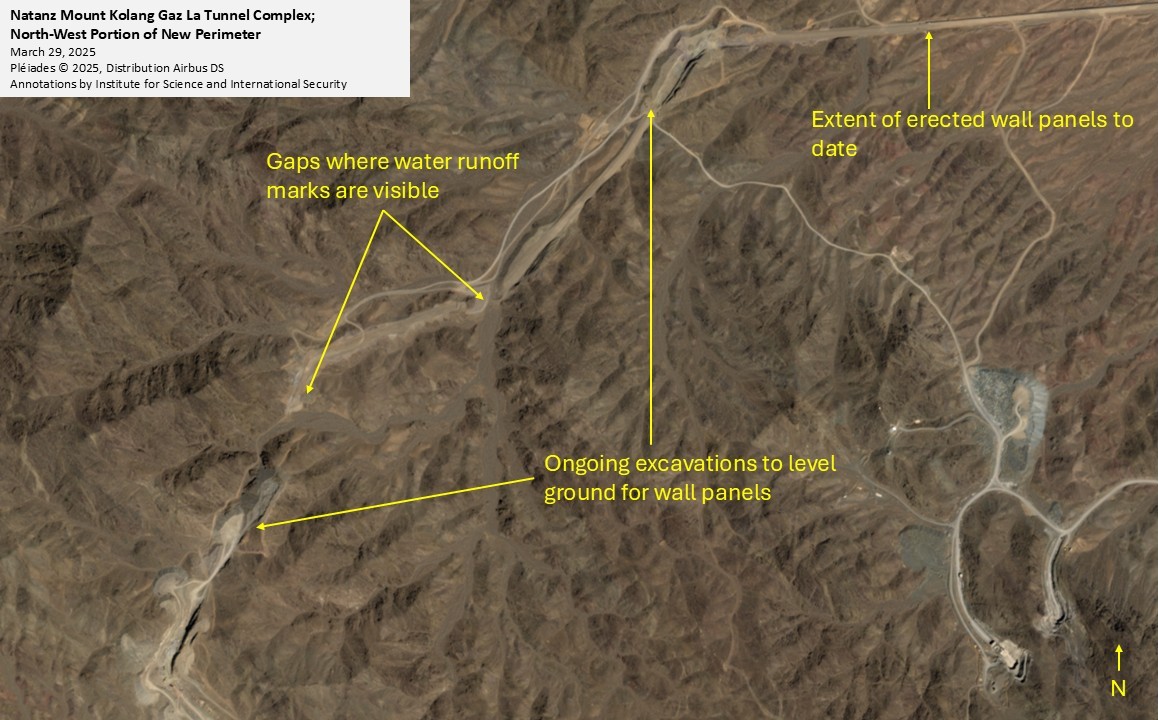New commercial satellite imagery shows the construction of a new security perimeter around the base of Mt. Kolang Gaz La, located south of the Natanz enrichment complex. The multi-peaked mountain contains a new, large, deeply buried tunnel complex and a separate, smaller one dating to 2007, neither of which has been visited by the International Atomic Energy Agency (IAEA). The security perimeter encircles the base of the mountain peaks, extending all the way to the main road, joining with the one around the nearby Natanz enrichment complex (see Figure 1).
The creation of a security perimeter around deeply buried sites associated with uranium enrichment suggests that Iran is increasingly worried about an individual or group seeking to enter the tunnel complexes undetected. Whether this type of protective barrier would be effective against a well-armed and resourced adversary is unclear.
Figure 1. A security perimeter is being constructed around multiple peaks of Mount Kolang Gaz La, which holds two underground tunnel complexes.
Under the Peaks of Mount Kolang Gaz La
The New Large Underground Complex
The new tunnel complex, with two sets of tunnel entrances likely leading under the highest peak of Mt. Kolang Gaz La, has been under construction for several years. [1] When fully finished, which may occur this year or next, this complex will hold an advanced centrifuge assembly facility that replaces an above ground one at the main Natanz site that was destroyed by an explosion in the summer of 2020. The new complex features halls more deeply buried than the Fordow uranium enrichment site, itself deeply buried. [2] The estimated floor space provided by the mountain peak suggests that it may also house additional sensitive capabilities; most worrisome, a small undeclared gas centrifuge facility. Given that Iran has deployed about 6000 advanced centrifuges at Fordow and the Natanz Fuel Enrichment Plant (FEP) over the last year, all produced outside of International Atomic Energy Agency (IAEA) monitoring, Iran appears capable of secretly deploying a few thousand advanced centrifuges in the new tunnel complex.
The Original Underground Facility
The original tunnel complex, which is physically separated from the new one, was first revealed by the Institute in 2007 and is much smaller than the new one. [3] Recent satellite imagery shows considerable work around its tunnel entrances apparently aimed at hardening this complex and creating a highly secure tunnel site (see Figure 2). Nonetheless, Iran has not provided any information about this site's exact purpose. No evidence has emerged that it has housed a small centrifuge plant, but it was likely built as an emergency storage facility for natural or enriched uranium stocks, or centrifuge related equipment, such as centrifuge manufacturing and assembly equipment, centrifuge rotor assemblies and other centrifuge components. It may have been intended as a place to conduct small-scale centrifuge research and development activities. A few years earlier, Iran built a tunnel complex near the Esfahan Uranium Conversion Facility (UCF) to protect natural uranium hexafluoride and a range of uranium conversion-related equipment and materials, and possibly to conduct small-scale operations. [4] The Esfahan tunnel site was visited by the IAEA, but Iran would not allow the IAEA to visit the Natanz tunnel complex in 2007 or afterwards.
Figure 2. Recent changes at the 2007 Natanz Tunnel facility show efforts to create a highly secure site.
Safeguards Issues?
Neither of the Natanz tunnel facilities has been declared as a nuclear site. Under Code 3.1 of its safeguards agreement, Iran is required to provide design information to the IAEA as soon as it makes the decision to build an enrichment facility. However, Iran has refused to implement Code 3.1, which requires Iran to notify the IAEA and provide design information of a new nuclear facility prior to the start of construction. Considering Iran's record of building many clandestine nuclear facilities, getting greater clarity at what Iran intends to do at the underground sites under the peaks of Mt Kolang Gaz La should be a priority for the IAEA and all concerned countries. If Iran is building an enrichment plant and did not declare it to the IAEA when it authorized construction, this would be a serious safeguards violation.
In its negotiations with Iran, the United States should make clear that if Iran were to move, or has already moved enriched uranium stocks, centrifuges, or key centrifuge-related equipment to these underground facilities, this would be detrimental to negotiations.
Operational Status
The operational status of either tunnel facility is difficult to discern, although the construction of a security perimeter around the mountain implies that operation is expected relatively soon.
There is little reason to doubt that the original, 2007 site is operational, given recent construction activities visible at the tunnel entrances in commercial satellite imagery viewed by the Good ISIS team. This whole site was dormant for more than a decade and then was slowly reactivated about five years ago with dramatic changes in the inner security perimeters at its tunnel entrances since September 30, 2023, based on surveying commercial satellite imagery of the site. In the last six months, the changes have further accelerated. The two tunnel entrances are highly secured with entrance security buildings, with moveable road blocks leading to the upper one. The security perimeter of the upper tunnel entrance has changed and an elaborate extension with alcoves has been added, although construction does not appear finished. Overall, the satellite imagery indicates this site is becoming a highly secured site. But it is unclear if the two sites are related in their functions.
The status of the new, larger tunnel complex is harder to discern. The two visible sets of tunnel entrances, where one set appears largely complete while the other appears burdened with water outflow challenges, increase the likelihood of Iran starting operations in one portion before the entire complex is ready. However, the roads leading into the tunnels remain unpaved, and gaps in the security perimeter remain, as discussed below. Nonetheless, at least one Western government worries that part of the new tunnel complex may be operational already.
The Security Perimeter Viewed by Commercial Satellite Imagery
Satellite imagery dated to the end of March shows that extensive road grading and levelling efforts are underway to install a security perimeter around the whole site, adjoining the Natanz enrichment complex to the new Mount Kolang Gaz La tunnel complex (see Figure 1). The installation of wall panels along the perimeter has begun and is accelerated by installation from two sides, the north and the east sides, leaving a gap on the west side as of March 29, 2025. On the north side, the perimeter joins the pre-existing perimeter established around the Natanz enrichment complex; on the east site, it extends towards the nearby road. This way, it includes not only the Mount Kolang Gaz La tunnel entrances and support infrastructure, but also the pre-existing tunnel entrance and underground hall built before 2007.
Due to the mountainous terrain, levelling the ground for installation of wall panels requires notable excavation efforts and machinery in some parts. Figure 3 shows the end of the erected wall panelling and the ongoing efforts to level the ground in the northwest area of the perimeter. Figure 4 shows the end of the erected wall panelling on the south side, where underpasses are also constructed, likely for runoff water. Figures 5 and 6 provide a close up of the perimeter wall construction on the south side.
Trenching is visible along parts of the perimeter, which appears at least partially related to runoff. Other trenching could serve for laying underground cables, such as for lighting and camera surveillance. The road grading is wide enough to establish a double security perimeter with wall panels and a fence lined with light poles and cameras (see Figure 6).
Figure 3. The northwest portion of the perimeter is undergoing road grading and installation of wall panels.
Figure 4. The southwest portion of the perimeter shows ongoing installation of wall panels and construction of underpasses.
Figure 5. A close up of wall panelling underway.
Figure 6. A close up of the construction of a water diversion culvert on the south side of the perimeter.
1. David Albright, Sarah Burkhard, and John Hannah, "Iran's Natanz Tunnel Complex: Deeper, Larger than Expected," Institute for Science and International Security, January 13, 2022, https://isis-online.org/isis-reports/detail/irans-natanz-tunnel-complex-deeper-larger-than-expected/8↩
2. "Iran's Natanz Tunnel Complex: Deeper, Larger than Expected." [↩]
3. David Albright and Paul Brannan ,"New Tunnel Construction at Mountain Adjacent to the Natanz Enrichment Complex," Institute for Science and International Security, July 9, 2007, https://isis-online.org/uploads/isis-reports/documents/IranNatanzTunnels.pdf. [↩]
4. "New Satellite Images Show Tunnel Construction at Esfahan Facility in Iran," Institute for Science and International Security, February 17, 2005, http://www.isis-online.org/publications/iran/esfahantunnels.html; see also http://www.isisonline.org/publications/iran/newactivities.pdf. [↩]












